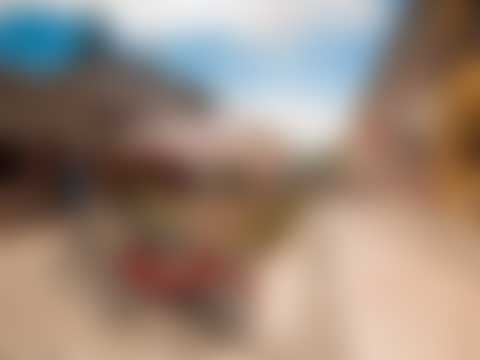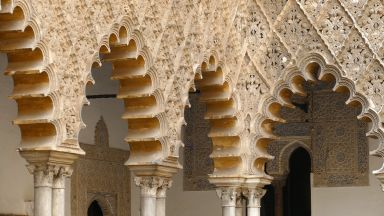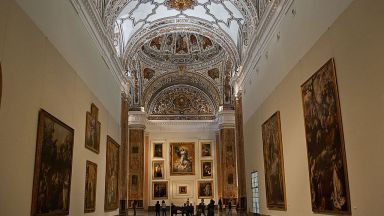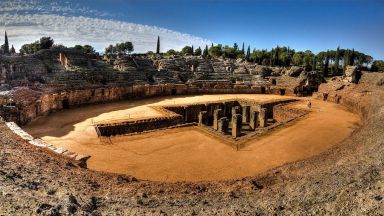Monasterio de la Cartuja (Charterhouse)
Historic Building, Monastery and Museum in Seville
The Monastery of Santa María de las Cuevas, is a religious building on the Isla de La Cartuja in Seville, southern Spain. The building is a large, walled complex of honey-colored stone buildings, situated on the Isla la Cartuja which is named after the monastery itself – the word meaning ;charterhouse’. The monastery has had a long, dramatic history. From monks who welcomed Christopher Columbus, to barracks for Napoleon’s troops, ceramic factory run by an Englishman producing world-renowned porcelain, to modern-day contemporary art gallery and open-air live music venue.
Visiting the Monasterio de la Cartuja
The 16th-century monastery consists of a magnificent entrance gate with surrounding grounds and lake. Inside are a domed church with various chapels and Mudejar cloisters, a refectory with wood coffered ceiling; crypt and a chapterhouse with tombs.
The grounds have numerous patios, a beautiful walled garden with fruit trees and a small Mudejar torreon (tower) with mirador offering views over the river Guadalquivir to the city.
There is a café with an attractive outdoor seating area, which is never too crowded with tourists as few venture over here.
History of Monasterio de la Cartuja
Hermitage of Santa Maria de las Cuevas
Before becoming a monastic land, the Almohads used it in the 12th century by placing pottery kilns in the area, taking advantage of its location next to the river. Caves needed to be dug in the area to extract clay, to make the pots. Legend has it that in 1248, the year Seville fell to the Christian King Ferdinand III of Castile, an image of the Virgin was found in one of the caves.
Hermitage of Santa Maria de las Cuevas was built to venerate the icon and was managed by the Franciscan Order. In 1400 Franciscans built a monastery here, founded by the Archbishop of Seville, Don Gonzalo de Mena and helped by the noble Ruy González de Medina.
Later constructions were patronized by don Perafán de Ribera, who built the Casa de Pilatos. In the 15th century, monks of the cloistered order of Saint Bruno were housed in the monastery.
Fashionable with the rich and powerful of Spain, La Cartuja was where Christopher Columbus stayed while planning his second voyage. After being interred at Valladolid, Christopher Columbus’ remains were moved to the Monastery of the Cartuja and were buried here 30 years. In 1542 the remains were transferred to Colonial Santo Domingo.
During the Napoleonic invasion of Spain, the monastery was sacked and the monks were expelled. La Cartuja was then used as a barracks by the French Emperor’s troops, who damaged the buildings. They finally left in 1812, and the monks came back until the closing and confiscation of many religious properties with the general closure of monasteries in 1835–36.
English Tile factory
The Englishman Charles Pickman, acquired the Carthusian Monastery of Santa Maria de las Cuevas in 1839. In 1841 utilizing British ceramist experience he installed a factory making ceramic tiles and porcelain. He employed pottery workers from nearby Triana and built the emblematic tall, cone-shaped brick kilns and chimneys. By the middle of the 19th century Seville was connected to Cadiz and Cordoba by rail, and Pickman was able to export his decorative pottery world wide. La Cartuja de Sevilla becoming a popular pottery brand in Europe and in Latin American countries. Even producing commissions for various Spanish monarchs, including Alfonso XIII of the famous Seville hotel. The factory ceased production in the 1980s.
The company La Cartuja still exists today, though the factory itself is now located in Salteras, in the Aljarafe area to the east of Seville. The Pickman Collection, which consists of 15,000 19th and 20th-century pieces, is in the Museo de la Fabrica (the Factory Museum), which can be visited by arrangement.
In Seville city centre, you can see La Cartuja pieces in the Museo de Artes y Costumbres Populares, in the Parque Maria Luisa.
Seville’s Expo 92
The island of La Cartuja, including the then-ruined monastery – was chosen for Seville’s Expo 92, on the 500th anniversary of Christopher Columbus’ 1492 voyage.
The Centro Andaluz de Arte Contemporáneo
The Centro Andaluz de Arte Contemporaneo Seville’s museum of modern art now set in the former monastery. It is a wonderful setting where old classic architecture blends with modern masterpieces. The CAAC offers both modern Spanish and international art from a permanent collection as well as temporary exhibitions.
The Contemporary Art Centre has a permanent collection focused in particular on the history of contemporary Andalusian art. Temporary exhibitions, seminars, workshops, concerts, meetings, recitals, film cycles and lectures are also held at the museum.
In summer you can also watch open-air concerts in the grounds of La Cartuja.
The Monasterio de la Cartuja (Charterhouse) appears in our Complete Guide to Visiting Seville!
Other names of Monasterio de la Cartuja (Charterhouse)
The Monasterio de la Cartuja (Charterhouse) has the following names: Monastery of Santa Maria de las Cuevas, Monastery of the Cartuja .
This website uses affiliate links which may earn a commission at no additional cost to you!
Visiting Monasterio de la Cartuja (Charterhouse)
Tuesday to Saturday: 11.00 – 21.00 hrs.
Sunday: 11.00 – 15.00 hrs.
Monday: Closed.
1.80 € (Monument or temporary exhibitions); 3.01 € (Full visit).
Nearby Attractions
- Pabellón de la Navegación (0.5) km
Museum in Seville - CaixaForum Seville (0.5) km
Gallery and Notable Building in Seville - Museo de Bellas Artes (1.0) km
Gallery and Historic Building in Seville - Alameda de Hércules (1.3) km
Park in Seville - Museo de la Cerámica de Triana (1.5) km
Museum in Seville - Triana Market (1.5) km
Market in Seville - Palacio de Lebrija (1.5) km
Historic Building and Museum in Seville - Castillo de San Jorge (1.5) km
Castle and Museum in Seville - Palacio de los Marqueses de la Algaba (1.6) km
Palace in Seville - Metropol Parasol (Las Setas de Sevilla) (1.6) km
Area, Monument and Notable Building in Seville



